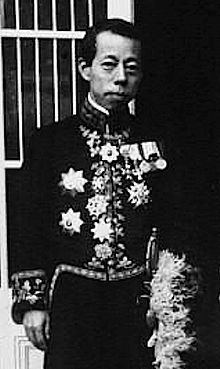Monarch Hirohito Political party Rikken Seiyukai | Alma mater Tokyo University Succeeded by Saito Makoto Name Kenkichi Yoshizawa | |
 | ||
Died January 5, 1965, Tokyo, Japan | ||
Kenkichi Yoshizawa (芳沢 謙吉, Yoshizawa Kenkichi, 24 January 1874 – 5 January 1965) was a Japanese diplomat in the Empire of Japan, serving as 46th Foreign Minister of Japan in 1932. He was the maternal grandfather of Sadako Ogata, the former United Nations High Commissioner for Refugees from 1991-2001.
Contents
Biography
Yoshizawa was a native of what is now part of Joetsu city, Niigata Prefecture. He was a graduate of the English literature department of the Tokyo Imperial University and entered the Ministry of Foreign Affairs in 1899. He was assigned to the Japanese consulate in Amoy, China in 1902, and later to the consulate in Shanghai.
In 1905, Yoshizawa married the eldest daughter of politician (and future Prime Minister) Tsuyoshi Inukai, and moved to London. He continued to live in England for the next several years, eventually becoming First Secretary to the Japanese embassy. He was given the post of Consul-General in Hankou, China in 1912.
Diplomatic career
Yoshizawa served as Minister to China from 1923-1929, and was stationed at the Japanese consulates at Beijing and Tianjin. He met with Soviet Foreign Minister Lev Karakhan in Beijing in 1925 for talks which led to the formal establishment of diplomatic relations between Japan and the Soviet Union per the Soviet–Japanese Basic Convention.
Yoshizawa later served as Japanese ambassador to France and official representative to the League of Nations.
He was appointed to the cabinet of Prime Minister Inukai Tsuyoshi as Foreign Minister from January 14, 1932 to May 26, 1932. On receiving word of his appointment, Yoshizawa traveled from Europe back to Japan via the Trans-Siberian Railway and Manchuria to see conditions first-hand. Following the assassination of Inukai in the May 15 Incident, the Inukai cabinet was dissolved. However, Yoshizawa received an appointment to the House of Peers (present day House of Councillors) by command of Emperor Shōwa, and joined the Rikken Seiyūkai political party.
In the period immediately prior to the start of the Pacific War, Yoshizawa was appointed as a special envoy by Prime Minister Fumimaro Konoe to the Netherlands East Indies following the diplomatic mission of Ichizo Kobayashi. Yoshizawa was assigned to present a new set of demands on the Dutch government in Batavia, which were deliberately intended to be unacceptable.
In December 1940, Yoshizawa was met by Hubertus Johannes van Mook, deputy minister of Economic Affairs, K. L. J. Enthoven, director of Justice, and Hoessein Djajadiningrat, director of Education and Religion. The negotiations dragged on unsuccessfully, and on June 11, 1941, the Liaison Meeting of the Imperial General Headquarters and Government decided to recall Yoshizawa and terminate the talks. Yoshizawa suddenly announced to the Dutch his plan to depart and asked to be received by the Dutch Governor-General A. W. L. Tjarda van Starkenborgh Stachouwer on June 17, 1941. The latter was worried that he might receive a declaration of war, but to his relief Yoshizawa only handed him a draft declaration stating that the negotiations had ended without an agreement.
From 1941-1944, Yoshizawa served as Japanese ambassador to French Indochina. The posting was mostly symbolic, as by then mostly under Japanese military occupation. In August 1945, he became a member of the Privy Council.
After the end of World War II, the surrender of Japan, Yoshizawa was purged from public office by the American occupation authorities. In post-war Japan, he was appointed as Japanese ambassador to the Republic of China on Taiwan in 1952. He retired from public life in December 1956.
